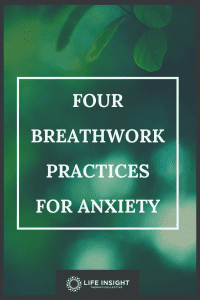Four Breathwork Practices for Anxiety
What if I told you that the simple act of breathing properly could decrease anxiety and improve your overall health with just minutes of practice a few times per week? Kind of wild, right? It’s actually true.
Studies show that diaphragmatic breathing (or, deep breathing) is effective in increasing attention span, lowering cortisol levels, and decreasing negative emotional state. Deep breathing causes our bodies to experience a relaxation response which turns out our “fight or flight” response to stress.
Learning to breathe deeply can feel unnatural since we do not come close to using our entire lung capacity, even when we are exercising. When you are properly deep breathing, you use your nose to draw in a breath, and fill your diaphragm with air, causing your belly to rise as you breathe in fully. Some benefits of breathing deeply other than decreasing stress include pain relief, detoxification of the body by stimulating the lymphatic system, improved immunity, an increase in energy levels, lower blood pressure, improved digestion, and support for correct posture.
While there are a lot of breathing techniques out there, some methods of breathing for anxiety we are going to discuss here include the 4-7-8 method, alternate nostril breathing, box breathing, and breath counting (a way of practicing mindful breathing).
4-7-8
This breathing technique is easy to learn, and quick to practice. Its effects are often felt immediately and is known to be a good way to work against insomnia as well as an effective way to mitigate anxiety and create a calm mind.
- Sit straight up, or lay down to practice the exercise.
- Exhale completely through the mouth, making a “whoosh” sound.
- Inhale through your nose for a count of four.
- Hold your breath for a count of seven.
- Exhale completely through your mouth for a count of eight.
- Repeat three more times for a total of four breaths.
With this technique it is easy to get light-headed if you are new to the pattern of breathing, so adjust as needed, maybe only practice for three breaths and breathe normally for a while before repeating the pattern again. If 4-7-8 is too much time, you may try decreasing the time spent on each piece, but keep the 4-7-8 ratio the same.
Alternate Nostril Breathing
In a 2011 study, alternate nostril breathing was shown to positively influence heart rate, blood pressure, and lung capacity. In 2013, a study showed that people practicing alternate nostril breathing experienced lower perceived stress levels. For best results, you should practice this technique for 30 minutes 3 days per week.
When Hillary Clinton wrote in her book What Happened about coping with her loss of the presidential election in 2016, she disclosed that she used the alternate nostril breathing technique to manage her stress and anxiety.
- Sit in a comfortable place with your legs crossed.
- With your dominant hand, make the “hang loose” sign, and then raise your ring finger to join your pinky finger. This is the hand posture used for this technique.
- Exhale deeply out of your mouth with a “whoosh” sound.
- With your thumb, close your right nostril and breathe in through your left nostril. (If left-handed, use your ring finger.)
- Close your left nostril with your ring finger.
- Open the right nostril and exhale through this side.
- Keep your hand where it is, and inhale through your right nostril.
- Close your right nostril.
- Open the left nostril and exhale through this side.
You should keep your breath slow & steady while practicing this technique. Repeat as many times as you wish, up to 5 minutes. Always finish by exhaling on the left side.
Box Breathing
Also known as square breathing, this is a technique used to encourage deep, slow breaths and a heightened awareness of your breath.
- Exhale through your mouth with a “whoosh” to empty out your lungs.
- Inhale slowly and deeply through your nose for a slow count of four.
- As you inhale, notice the feeling of your breath filling up all parts of your lungs and into your diaphragm.
- Hold your breath for a count of four.
- Exhale through your mouth for the same slow count of four.
- Hold your breath for a count of four before beginning again.
- Repeat three times for a total of four cycles.
Try to keep that count of four equal each time. Don’t rush, but also don’t make it so slow that you are uncomfortable. Keep the pace even and unhurried. You can do this practice whenever you need to calm your nerves or release stress.
Breath Counting
Breath counting is a way of being incredibly intentional and mindful while practicing breathwork. For this practice, you will want to allow your breath to come naturally, and not force it for any specific length of time.
- Try to find a quiet place where you can focus.
- Exhale with a whoosh and count “one”
- Breathe naturally. On the next exhale count “two”
- Continue counting your breath until you count five total breaths. This is one complete cycle.
- On the next breath start again with “one”. Repeat as many cycles as you wish.
The practice here uses mindfulness to allow your brain to loosely focus on your breath and relax, while remaining present in your mind enough to not count above five breaths per cycle. You’ll know your mind has wandered when you find you’ve counted “eight” or “fifteen” breaths in a cycle.
Go ahead and give one of these breathwork patterns a try. Practicing them when you are not under stress or anxiety makes it easier to practice when you are feeling anxious. All of these breath patterns are great options for helping with insomnia as well.
These helpful tools are great options for self-treating mild to moderate cases of anxiety but should never replace seeing a certified therapist. If you suffer from anxiety, please reach out to us to schedule an appointment with one of our counselors. We are here to help.
If, while practicing any of these breathing techniques, you feel short of breath or have any other negative effects such as dizziness or nausea, please stop practicing.

Join Our Community.
Sign up for our quarterly newsletter with practice news, timely resources, staff highlights, and other helpful tidbits!
Recent Posts






